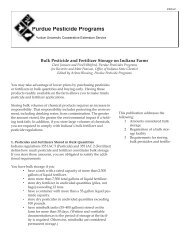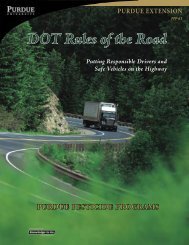Pesticides and Risk Communication PPP-52 - Purdue Pesticide ...
Pesticides and Risk Communication PPP-52 - Purdue Pesticide ...
Pesticides and Risk Communication PPP-52 - Purdue Pesticide ...
Create successful ePaper yourself
Turn your PDF publications into a flip-book with our unique Google optimized e-Paper software.
12<br />
cited as the basis for enforcement actions such as fines, probation,<br />
<strong>and</strong> license revocation; <strong>and</strong> it is often questioned why EPA<br />
<strong>and</strong> its state counterparts do not police pesticide applications<br />
more diligently to deter or identify misuse incidents.<br />
• <strong>Pesticide</strong> manufacturers are required by law to report (to EPA)<br />
any problems associated with their products. This requirement<br />
facilitates follow-up on products that impact human health <strong>and</strong> the<br />
environment adversely. But although the law requires manufacturers<br />
to report suspected problems, they are trusted to do so<br />
voluntarily.<br />
An Overview of the<br />
Registration Process<br />
Manufacturers spend millions of dollars on product research, countless<br />
hours working on EPA registrations, <strong>and</strong> even more energy advertising<br />
in the marketplace. There is infinite pressure on manufacturers to<br />
develop new products <strong>and</strong> to meet EPA registration requirements. But<br />
their products must generate enough revenue to return the initial<br />
investment <strong>and</strong> earn profits for the company <strong>and</strong> its shareholders.<br />
Manufacturers must supply scientific evidence<br />
that a pesticide, when used as directed by<br />
the label, will not injure humans, crops,<br />
livestock, <strong>and</strong> other nontarget organisms<br />
or the environment, <strong>and</strong> that it<br />
will not produce illegal residues on or in<br />
food <strong>and</strong> feed. The steps manufacturers<br />
use to meet these requirements are complex<br />
<strong>and</strong> lengthy.<br />
Generation of chemicals for screening. Traditionally, companies<br />
have synthesized thous<strong>and</strong>s of novel chemicals for testing every year;<br />
<strong>and</strong> for every successful new compound they produce, dozens prove<br />
unworthy <strong>and</strong> are scrapped. The attrition rate has risen sharply over the<br />
years.




